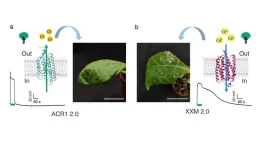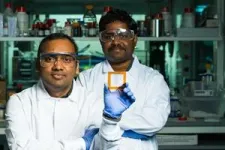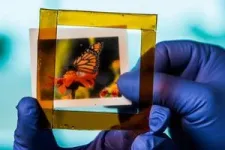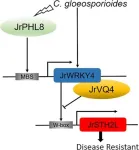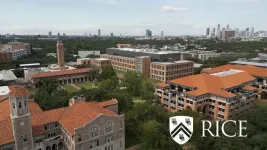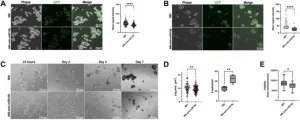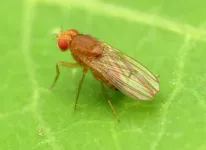(Press-News.org) When it comes to survival, plants have a huge disadvantage compared to many other living organisms: they cannot simply change their location if predators or pathogens attack them or the environmental conditions change to their disadvantage.
For this reason, plants have developed different strategies with which they react to such attacks. Such reactions are usually triggered by certain signals from the environment. As has long been known, the intracellular calcium concentration plays an important role in the processing of these signals.
However, in addition to changes in the cytoplasmic calcium level, changes in the cell's membrane potential have also been suspected as a signal transmitter. Research groups from the Departments of Neurophysiology, Pharmaceutical Biology and Botany at Julius-Maximilians-Universität Würzburg (JMU) have investigated the calcium-membrane potential relationship in more detail. They have now published their findings in the journal Nature.
Light-sensitive Channels Enable Targeted Manipulations
For their study, the research teams worked with tobacco plants that carry ion channels that can be specifically switched on with light. More than 20 years ago, Peter Hegemann, Georg Nagel and Ernst Bamberg initiated the success of optogenetics, with their discovery and characterization of light-activated ion channels, so-called channelrhodopsins. With the help of these light-sensitive proteins, which are obtained from algae and microorganisms, the JMU researchers were able to experimentally investigate whether the influx of calcium ions or anion efflux-mediated depolarization of the cell membrane is decisive for the plant's reaction to a certain stress situation. However, the scientists had to do a great deal of preparatory work before they were able to do this.
Optogenetics with Rhodopsins
Channelrhodopsins, ion channels that carry an intrinsic rhodopsin-based light switch, revolutionized neuroscience through the light-controlled investigation of neuronal networks. The use of channelrhodopsins in plant research only became possible 20 years later, through close collaboration between the group of Georg Nagel, Professor at the Institute of Physiology at JMU, and plant researchers from the Würzburg Chairs of Botany 1, 2 and Pharmaceutical Biology.
In 2021, Georg Nagel's group, together with Dr. Kai Konrad, group leader at the JMU Chair of Prof. Rainer Hedrich Botany 1, published an approach to optimize the use of channelrhodopsins in plants by overcoming three main difficulties.
Rhodopsins Require Vitamin A
Point 1: “Like all rhodopsins, including those in our eyes, channelrhodopsins require the small molecule retinal, also known as vitamin A, to absorb light. We humans get retinal mainly from beta-carotene, the provitamin A. However, land plants do not contain retinal, but a lot of beta-carotene,” explains Dr. Shiqiang Gao, co-author of the Nature publication and ‘rhodopsin engineer’ from the Optogenetics lab of the Department of Neurophysiology at JMU.
In 2021, Gao succeeded for the first time in combining the expression of channelrhodopsins with the production of retinal from beta-carotene in plant cells. This enabled the development of tobacco plants with a high retinal content and successful expression of channelrhodopsins.
Dr. Markus Krischke from the Metabolomics Core Unit at the Department of Pharmaceutical Biology headed by Professor Martin Müller at JMU Würzburg confirmed the high retinal content of the various transgenic tobacco plants.
Comparable transgenic tobacco plants were produced for the recently published study by Dr. Meiqi Ding from the Department of Botany I under the direction of plant physiologist and expert for plant signal processing Dr. Kai Konrad from the group of Professor Rainer Hedrich at the Department of Botany I.
Plants Need Light to Grow
Point 2: “Most rhodopsins are activated by blue or green light. However, this is always a component of white light,” explains Georg Nagel. As a result, the tobacco plants could not be grown in a greenhouse or under artificial white light, as is usually the case. Only in special growth chambers with red LED light, which can be used photosynthetically, it was possible to avoid unwanted rhodopsin activation. Tests under different growth conditions showed: “Tobacco develops healthily and unchanged under red light compared to greenhouse conditions,” says Dr. Kai Konrad.
Functional Expression of Channelrhodopsins in Plants
Point 3: The expression of chanelrhodopsin in tobacco cells often causes difficulties. In 2021, the Würzburg team of scientists succeeded in expressing the light-activated anion channel GtACR1 in tobacco plant cells. As a result, Georg Nagel's team was able to develop various channelrhodopsins that were optimized for the permeability of calcium ions. Finally, Dr. Shiqiang Gao and Dr. Shang Yang, both members of Nagel's group, succeeded in developing a very good calcium-conducting channelrhodopsin XXM 2.0 for targeted expression in tobacco plants.
This was the breakthrough: “The successful expression of channelrhodopsins with different ion selectivity in plant cells enables the comparison of different ion signals in parallel to the electrical signal, the so-called depolarization,” explains Dr. Meiqi Ding. She used the calcium-conducting channelrhodopsin XXM 2.0 and the light-activated anion channel GtACR1 to investigate the different ion signaling pathways in tobacco.
A New Era in Plant Research
These newly generated “optogenetic” tobacco plants made it possible to clarify the question of whether calcium influx or membrane depolarization is decisive for the plant's response to a specific stress situation. “The answer was clear,” says Dr. Kai Konrad, corresponding author. First author Dr. Meiqi Ding from Dr. Konrad's group explains, “After activation of the anion channel, the leaves wilted and responded with the typical plant response to drought; the plant hormone abscisic acid (ABA) was produced and gene expression was ramped up to protect against desiccation.”
“However, in the plants with the calcium channel, there was no change in ABA levels after optogenetic stimulation,” Dr. Ding continued. “Instead, the plants produced signal molecules and plant hormones to initiate defence mechanisms against predators, recognizable by white spots on the leaves,” said Dr. Konrad.
Dr Sönke Scherzer at the chair of Prof Hedrich was able to show by direct ROS measurements that reactive oxygen species (ROS) are released in the process.
Dirk Becker and Rainer Hedrich at the Chair of Botany 1, designed an experimental approach to support the working hypothesis using transcriptomic and bioinformatic analysis.
The scientists are convinced that this study is just the beginning of a new era in plant research. Ultimately, the signaling pathways of plants can now be better “illuminated” using various rhodopsins.
Contact
Dr. Kai Konrad, Julius-Maximilians-Universität Würzburg, kai.konrad@uni-wuerzburg.de
Dr. Shiqiang Gao, Institute of Physiology – Neurophysiology, gao.shiqiang@uni-wuerzburg.de
END
Plant signaling pathways decoded
2024-08-28
ELSE PRESS RELEASES FROM THIS DATE:
Fighting fungal foes: Walnut's genetic armor against anthracnose revealed
2024-08-28
A pivotal study has pinpointed a gene module crucial for enhancing walnut trees' resistance to anthracnose, a widespread fungal disease threatening the walnut industry. The research reveals how the JrPHL8-JrWRKY4-JrSTH2L module regulates disease defense, opening up new opportunities for breeding resistant walnut varieties and promoting sustainable cultivation practices.
Anthracnose, caused by Colletotrichum gloeosporioides, poses a significant threat to walnut production, causing severe losses ...
Rice engineers develop AI system for real-time sensing of flooded roads
2024-08-28
Roadway-related incidents are a leading cause of flood fatalities nationwide, but limited flood-reporting tools make it difficult to evaluate road conditions in real time.
Existing tools — traffic cameras, water-level sensors and even social media data — can provide observations of flooding, but they are often not primarily designed for sensing flood conditions on roads and do not work in conjunction. A network of sensors could improve situational flood level awareness; however, they are expensive to operate at scale.
Engineers at Rice University have developed a possible solution to this problem: an automated data ...
Dr. David A. Schwartz receives 39th annual Alton Ochsner Award
2024-08-28
NEW ORLEANS – Ochsner Health has announced David A. Schwartz, MD, as the 2024 winner of the Alton Ochsner Award Relating Smoking and Disease. Dr. Schwartz is a Distinguished Professor of Medicine and Immunology and director of the Program to Advance Physician Scientists and Translational Research at University of Colorado’s Anschutz School of Medicine.
Dr. Schwartz won the 39th annual Alton Ochsner Award for his research on how genetic and environmental factors, including smoking, contribute to idiopathic pulmonary fibrosis (IPF). He found that ...
New data: Solar at K-12 schools quadrupled nationwide during the last ten years
2024-08-28
Charlottesville, VA — Schools across the country are rapidly switching to solar power to meet their energy needs while gaining significant cost-savings, boosting climate resilience, and supporting workforce development, according to a new report from clean energy nonprofit Generation180. Since the start of 2014, the amount of solar capacity installed at K-12 schools has more than quadrupled nationwide.
According to Brighter Future: A Study of Solar on K-12 Schools, 5th edition, over 6.2 million U.S. K-12 students– or more than one in nine students – now attend a school that utilizes solar power. In 2022-2023, over 800 schools added solar arrays, which is enough ...
Thermochromic material could make indoor temperature control more energy-efficient
2024-08-28
HOUSTON – (Aug. 28, 2024) – Rice University researchers have developed a smart material that adjusts its transparency with changes in temperature, outperforming similar materials in terms of durability, transparency and responsiveness. The new polymer blend could significantly enhance energy efficiency for indoor space cooling, according to a new study published in Joule.
Cooling off can be a matter of life or death, but air conditioning ⎯ when and if available ⎯ already accounts for 7% of the world’s energy use and 3% of carbon emissions. With temperatures hitting record ...
Damon Runyon Cancer Research Foundation awards $4.8 million to exceptional early-career scientists
2024-08-28
The Damon Runyon Cancer Research Foundation has named 16 new Damon Runyon Fellows, exceptional postdoctoral scientists conducting basic and translational cancer research in the laboratories of leading senior investigators. This prestigious Fellowship encourages the nation's most promising young scientists to pursue careers in cancer research by providing them with independent funding ($300,000 total) to investigate cancer causes, mechanisms, therapies, and prevention.
“What is so exciting—and so challenging—about being a postdoc is that you’re called to take what you know and apply ...
Primary care providers urged to assist patients who engage in emotional eating
2024-08-28
August 28, 2024 — Primary care providers are well positioned to address emotional eating because of their long-term relationships with patients, noted Jana DeSimone Wozniak, PhD and Hsiang Huang, MD, MPH, of Harvard Medical School and Cambridge Health Alliance in Cambridge, Massachusetts. According to their article published in Harvard Review of Psychiatry, part of the Lippincott portfolio from Wolters Kluwer, emotional eating is associated with myriad health problems, including the experience of ...
Half of Uber, Lyft trips replace more sustainable options
2024-08-28
More than 50% of ride-hailing trips taken by surveyed riders in California replaced more sustainable forms of transportation — such as walking, cycling, carpooling, and public transit — or created new vehicle miles, according to a study from the University of California, Davis Institute of Transportation Studies.
The study was conducted to help guide development of the Clean Miles Standard, a state regulation designed by the California Air Resources Board to reduce the greenhouse gas emissions from ride-hailing services.
Published in Transportation Research ...
miR-10b Inhibition: A strategy for treating metastatic breast cancer
2024-08-28
“We have developed a nanodrug, termed MN-anti-miR10b, that delivers anti-miR-10b antisense oligomers to cancer cells.”
BUFFALO, NY- August 28, 2024 – A new research paper was published in Oncotarget's Volume 15 on August 26, 2024, entitled, “Inhibition of miR-10b treats metastatic breast cancer by targeting stem cell-like properties.”
As stated within the Abstract of the paper, despite advances in breast cancer screening and treatment, the prognosis for metastatic disease remains dismal, with ...
Love is blind for male fruit flies who will choose sex over safety
2024-08-28
Male fruit flies will become oblivious to physical danger as they become more engaged in courtship and sex, new research shows.
Researchers at the University of Birmingham have shown that pursuit of a coveted reward – in this case a female fly – will cause a male fruit fly to ignore threats such as predation.
In the study, published today (28 Aug) in Nature, the team was able to show for the first time the neural networks in the fly’s brain that direct this decision-making process, revealing the neurotransmitter dopamine has a leading role to play.
Lead researcher Dr Carolina Rezaval said: “Every day we make decisions that require us to ...
